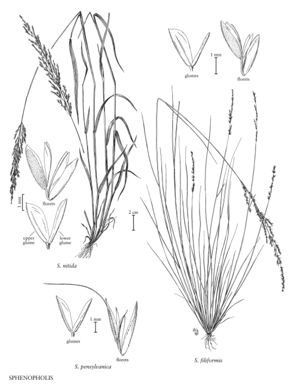Difference between revisions of "Sphenopholis filiformis"
FNA>Volume Importer |
imported>Volume Importer |
||
| (8 intermediate revisions by 2 users not shown) | |||
| Line 4: | Line 4: | ||
|publications= | |publications= | ||
|common_names=Southern wedgegrass | |common_names=Southern wedgegrass | ||
| + | |special_status={{Treatment/ID/Special_status | ||
| + | |code=E | ||
| + | |label=Endemic | ||
| + | }} | ||
|basionyms= | |basionyms= | ||
|synonyms= | |synonyms= | ||
| Line 17: | Line 21: | ||
-->{{Treatment/Body | -->{{Treatment/Body | ||
|distribution=Va.;Okla.;Ga.;Tex.;La.;Ala.;Tenn.;N.C.;S.C.;Ark.;Miss.;Fla. | |distribution=Va.;Okla.;Ga.;Tex.;La.;Ala.;Tenn.;N.C.;S.C.;Ark.;Miss.;Fla. | ||
| − | |discussion=<p>Sphenopholis filiformis grows in sandy soils of pine and mixed pine forests, at 0-500 m, in the southeastern United States. It is found primarily in the coastal plain, but extends to the piedmont. Smith (1991) reported it for northern Arkansas (Nielsen 4946, identification not verified). Sphenopholis filiformis differs from occasional forms of S. obtusata with somewhat scabrous distal lemmas in having narrower leaves.</p> | + | |discussion=<p><i>Sphenopholis filiformis</i> grows in sandy soils of pine and mixed pine forests, at 0-500 m, in the southeastern United States. It is found primarily in the coastal plain, but extends to the piedmont. Smith (1991) reported it for northern Arkansas (Nielsen 4946, identification not verified). <i>Sphenopholis filiformis</i> differs from occasional forms of <i>S. obtusata</i> with somewhat scabrous distal lemmas in having narrower leaves.</p> |
|tables= | |tables= | ||
|references= | |references= | ||
| Line 26: | Line 30: | ||
-->{{#Taxon: | -->{{#Taxon: | ||
name=Sphenopholis filiformis | name=Sphenopholis filiformis | ||
| − | |||
|authority=(Chapm.) Scribn. | |authority=(Chapm.) Scribn. | ||
|rank=species | |rank=species | ||
| Line 33: | Line 36: | ||
|basionyms= | |basionyms= | ||
|family=Poaceae | |family=Poaceae | ||
| + | |illustrator=Linda Ann Vorobik;Hana Pazdírková | ||
| + | |illustration copyright=Utah State University | ||
|distribution=Va.;Okla.;Ga.;Tex.;La.;Ala.;Tenn.;N.C.;S.C.;Ark.;Miss.;Fla. | |distribution=Va.;Okla.;Ga.;Tex.;La.;Ala.;Tenn.;N.C.;S.C.;Ark.;Miss.;Fla. | ||
|reference=None | |reference=None | ||
|publication title= | |publication title= | ||
|publication year= | |publication year= | ||
| − | |special status= | + | |special status=Endemic |
| − | |source xml=https:// | + | |source xml=https://bitbucket.org/aafc-mbb/fna-data-curation/src/200273ad09963decb8fc72550212de541d86569d/coarse_grained_fna_xml/V24/V24_887.xml |
|subfamily=Poaceae subfam. Pooideae | |subfamily=Poaceae subfam. Pooideae | ||
|tribe=Poaceae tribe Poeae | |tribe=Poaceae tribe Poeae | ||
Latest revision as of 17:25, 11 May 2021
Culms 20-100 cm. Sheaths smooth, usually glabrous, some¬times pubescent; ligules 0.4-0.75 mm, erose-ciliate; blades 2-45 cm long, 0.3-1.5(2) mm wide, involute to filiform. Panicles 5-15 cm long, 0.5-1(2) cm wide, sometimes nodding, spikelets loosely to densely arranged. Spikelets 2.3-5 mm. Lower glumes less than 1/3 as wide as the upper glumes, rarely slightly wider; upper glumes 1.8-2.9 mm, obovate to oblanceolate, width/length ratio 0.16-0.45, apices rounded to truncate; lowest lemmas 2-3 mm, scabridulous distally; distal lemmas scabrous on the sides, unawned or infrequently awned, awns (0.1)1-3 mm; anthers (0.5)1-1.9 mm. 2n = 14.
Distribution
Va., Okla., Ga., Tex., La., Ala., Tenn., N.C., S.C., Ark., Miss., Fla.
Discussion
Sphenopholis filiformis grows in sandy soils of pine and mixed pine forests, at 0-500 m, in the southeastern United States. It is found primarily in the coastal plain, but extends to the piedmont. Smith (1991) reported it for northern Arkansas (Nielsen 4946, identification not verified). Sphenopholis filiformis differs from occasional forms of S. obtusata with somewhat scabrous distal lemmas in having narrower leaves.
Selected References
None.
